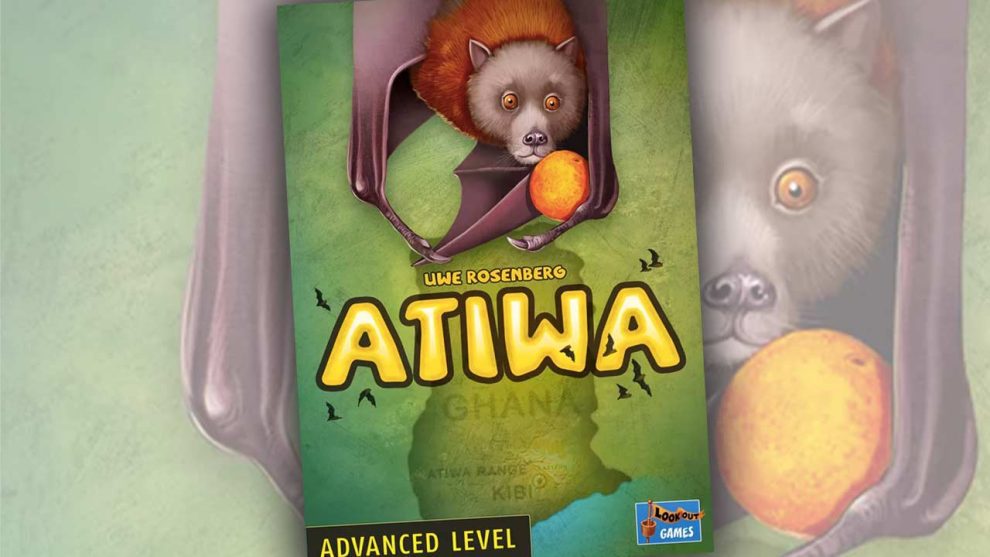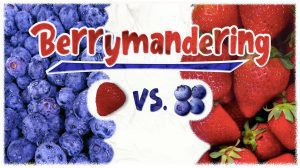Guano, for those not in the gua-know, is the accumulated fecal excrement of birds or bats. High in nitrogen, potassium, and phosphate content, it’s prized the world over as a fertilizer. It was also once highly coveted for its use in the production of gunpowder. However, with the introduction of modern day smokeless powders, gunpowder’s use (and, by default, guano’s usage therein) has sharply declined.
But in the Atiwa Range (pronounced “uh-TEA-wuh”), a forest preserve in the southeastern portion of modern day Ghana, guano is desirable for an entirely different reason: the seeds contained therein. For, you see, the Atiwa Range is home to a large number of fruit bats. And they, and their excrement, are key to the forest preserve’s survival. Logging, gold mining, and hunting for bushmeat have put the preserve under a lot of pressure and the lowly fruit bat just might be the key to relieving it. A single fruit bat can travel up to 60 miles a night in its search for fruit to eat. On its way back home, it will excrete the seeds of the consumed fruit over a large swath of ground. Multiply this behavior by 150,000 (the size of a large colony) and you’re talking about reforesting up to 2,000 acres of forest per year. And that’s just a single colony!
This circle of life—trees grow fruit which the bats eat, man cuts down trees to make room to live, bats excrete seeds to grow more trees which begets more fruit which begets more bats—is central to the theme and mechanics in Atiwa*. Each player begins the game with a small village populated with just a few people. Over the course of the game, players will begin growing their village, family by family, bat by bat, in an effort to expand their holdings and score more victory points than their opponents.
Of course, this is a very high-level overview of the game. If you’d like to find out how the game is played, keep reading. Otherwise, feel free to skip ahead to the Thoughts section to see what I think of Atiwa.
*One could say that Uwe Rosenberg wrote the book on worker placement, which is (however hyperbolic it may be) not too far from the truth. But, he literally wrote the book on the fruit bat situation in the Atiwa Range. So, if you can read German and you find the subject matter interesting, then you should check out “Weckruf aus Ghana” (ISBN 9783982184364) once it’s published later this year.
Setup
A game of Atiwa is set up thusly:
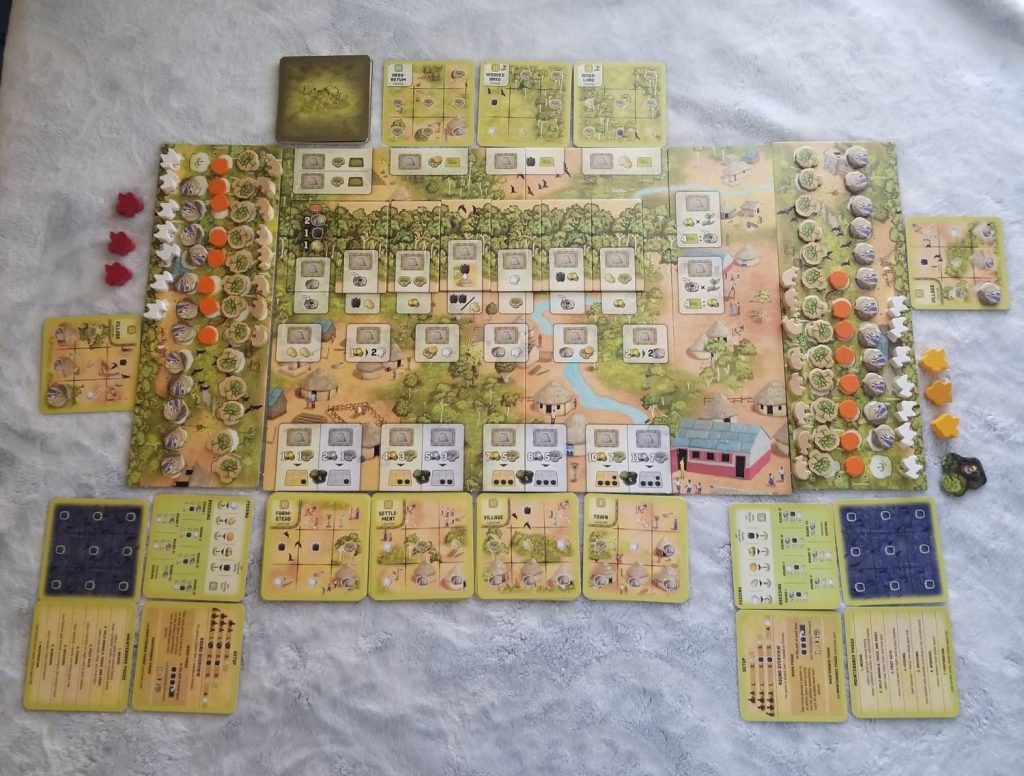
Place the Action board onto the table with the extension for the appropriate player count attached. Then, the Action space tiles are shuffled and placed onto their locations (the rightmost ones) in a random order. The Farmstead, Settlement, Village, and Town cards (collectively referred to as ‘Location cards’) are placed in stacks beneath their matching locations. The Terrain cards are shuffled and placed in a face down stack above the top left of the Action board and a number of these (according to player count) are revealed and placed face up along the top. Toss the Pollution tokens into the bag and set it aside for the time being.
Next, each player receives a Supply board along with eight Wild Animal, thirteen Tree, eight Fruit, thirteen Family, and seven Goat tokens which are placed on top of their matching spots. Each player also receives a Night card, one of each Overview card, and the Worker meeples in their chosen color. They also take a Village card which is placed into the third slot from the left beneath their Supply board. The leftmost Family token is removed from the player’s Supply board and placed into one of the huts on this card, untrained side up. The difference between the trained and untrained sides will be made clear later.
Finally, a start player is determined by some means, given the Start Player marker, and you’re ready to begin.
A Round of Play
Atiwa is played over a total of seven rounds. At the beginning of the game, all the Action tiles will be in their rightmost positions. But, at the beginning of subsequent rounds, the leftmost one will move one space to the left. This has the effect of changing up the available actions from one round to the next. Each Action tile represents a single action of a two action structure: the action shown on the tile and the pre-printed action that is visible just beneath it. There are other stand alone actions dotted all over the board aside from the ones coupled to the Action tiles.
On a player’s turn, they will place one of their workers onto an available action location, each of which can only accommodate a single worker, and then pay any associated costs before performing the action…or not. Players are allowed to place workers onto action spaces they have no intention of using if they choose to do so. And, players are not required to gain all the benefits from their chosen action location either. For example, if a player placed their worker on the space that rewards them with two Wild Animals, they could choose to take zero, one, or two animals.
In general, the various action spaces will allow you to gain resources, expand your holdings, or upgrade your Families. Aside from gold, any other resources will always come from your Supply Board. Any Terrain or Location card gained must be situated orthogonally adjacent to any already gained card and they can never be placed in such a way that they extend beyond the edges of your Supply board. So, each row may only consist of four cards, but you can have as many rows as you’d like. For the sake of this review, we’ll refer to this collection of Terrain/Location cards as your ‘tableau’.
After performing an action, if there are at least three Fruit bats in your tableau, you can send them to your Night card. To send your three Fruit bats to the Night card, you must pay a Fruit token (remove it from your tableau and place it back into the rightmost empty location on your Supply board). Then, you may place a Tree token from your Supply board into your tableau. Thematically, the bat has eaten a fruit and excreted its seeds during its nightly sojourn, resulting in a new tree.
Gaining Resources From the Supply Board
Any resources gained from your Supply board will always be placed into your tableau, but there are some very specific placement rules. For starters, Family tokens must always be placed into empty huts, untrained side up. So, if you don’t have any empty huts, you cannot gain anymore Family tokens. That’s the easy one.

The others—Wild Animals, Trees, Fruit, Bats, and Goats—are a little more complicated. In order to place the first one of these onto one of your cards, the card must contain a matching icon. For further copies of the same kind of token onto that card, the card must contain another matching icon OR a blank space. And, with very few exceptions, Fruit tokens may only be placed on top of Tree tokens. That means, in order to gain a Fruit token from an action, you must have an empty Tree token on one of your cards on which to place it.
End of the Round
A round ends after the last player has placed their third worker and carried out the associated action. Then there is a Maintenance phase that is carried out in steps. You are reminded of these steps with the handy Overview cards. In order, these steps are:
Income: Each trained Family rewards you with one gold from the supply. For each untrained Family, you’re going to have to delve into the bag of Pollution tokens. Each Pollution token features an ugly brown splotch on one side and zero to two gold nuggets on its backside. Reveal the backside of the token and collect any gold shown there. Then, the token is placed into your tableau where it will permanently cover up a space, evicting any resource that may have already been on the space. This pollution token can never be removed. Pollution is bad.
Wild Animals, Trees, and Fruit: Take a look at your Supply board and gain the rightmost uncovered reward from each row, starting with the top row and moving down. Wild Animals get you trees. Trees get you fruit. Fruit gets you bats.
Fruit Bats: All your Fruit bats return from your Night card back to your tableau to spaces featuring bat icons or blank spaces (as long as there’s at least one other bat on the card with the blank space). Trained Families can also accommodate a single bat in their hut. Not only are these Families more ecologically friendly when it comes to mining for gold, they also understand the importance that Fruit bats hold.
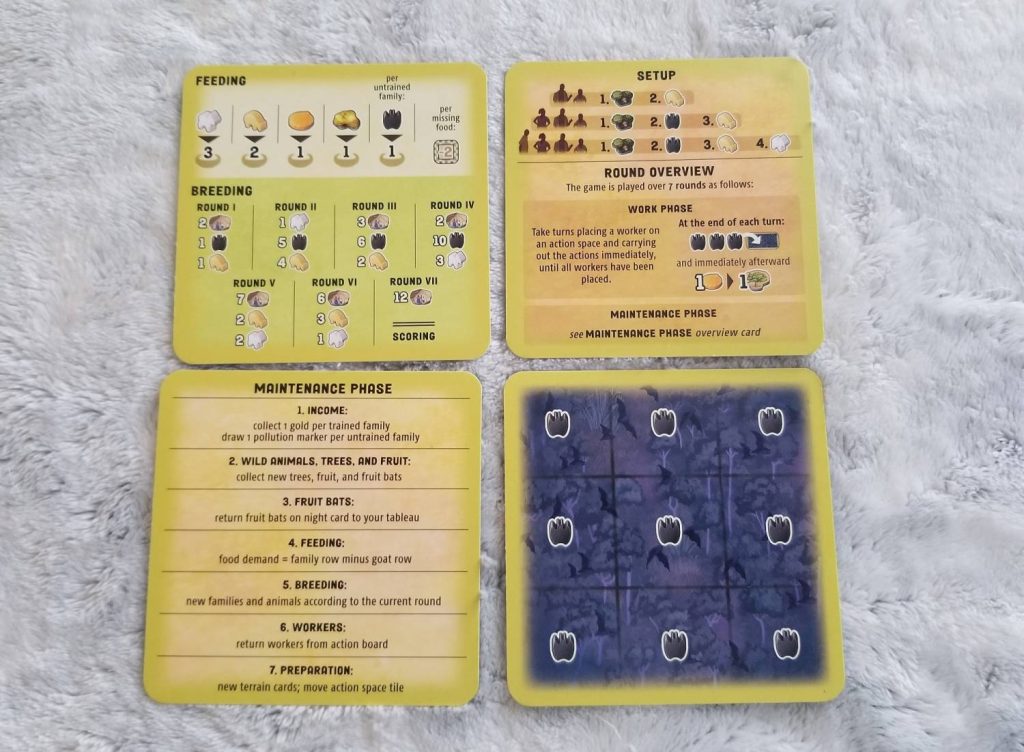
Feeding: To feed your Families, first determine the food demand. Subtract the number of the rightmost uncovered Goat from the number of the rightmost uncovered Family to determine the total. Then pay some combination of tokens and/or gold until this total is met. Wild Animals, Fruit, Goats, and Gold can be spent for different amounts. And untrained Families will even consume Fruit bats. You’ll lose two points for each unfed Family. However, in all the games that I have played, I have yet to see this happen. The food value of each item is shown on the Overview card.
Breeding: Different entities will breed each round, provided you have the right amount of stuff already in your tableau when this occurs—and as long as you’re able to accommodate the new stuff. For instance, at the end of Round 1, Families will generate a new Family if you have at least two existing Families in your tableau. But, in order to receive this new Family, you must have an empty hut in which they can live. The Overview card shows which entities breed at the end of each round along with their population requirements.
Workers: Gather your three workers from the Action board and return them to your play area.
Preparation: Discard any unselected Terrain cards and draw new ones to replace them. Then shift the Action tile to the right of the empty spot on the Action board one space to the left. Then the next round begins with whoever currently holds the Start Player marker (which shifts via the acquisition of Location cards).
End of the Game
When the game ends, players will add their points and then subtract any negatives they may have received from not feeding their families to obtain their final total. The player with the highest total wins. These points come from a variety of places: one point for each leftover gold; each tableau card is worth points; the rightmost uncovered spot of each Supply board row is worth the number of points printed on it; trained Families are worth a point each, and every Fruit bat in excess of ten is worth a point. Ties are broken by whoever has the least pollution.

Thoughts
When I first stumbled across Atiwa in Tony Boydell’s Everyone Needs a Shed blog, I was transfixed. A new Uwe Rosenberg game?! Featuring bats?! And just check out that artwork! I was desperate to know more. And so I followed it voraciously. Having done so, I was elated to find out it was going to be available for purchase at Essen. I knew someone that was going and I begged them to pick up a copy for me. A few weeks later, I was finally able to change that “In Collection (Pre-ordered)” on BGG to “In Collection (Own)”.
Atiwa had arrived.
The first thing that strikes you about Atiwa is the image of the fruit bat on its cover. He hangs there suspended upside down from the upper fame, an orange nestled within the folds of his wing. It’s an odd image if you don’t know what it is you’re looking at, as was the case with me the first time that I saw it.
“Is this some kind of dog? Is it a bear? Well, whatever it is, it’s super cute.”
It wasn’t until I’d delved deeper into Tony’s blog that I discovered it was the image of a fruit bat. Looking back, it should have been obvious. But how many games out there do you know of that heavily feature bats in a non-Halloween atmosphere? I’m willing to bet, not many. And I’m also willing to bet you haven’t played many games where the subject matter is so deeply ingrained into both the theme and the mechanics as it is in Atiwa.
From the moment you first crack open to the box to the moment you close it again after having packed the game away, it is obvious that Atiwa’s subject matter is something that Uwe Rosenberg holds very close to his heart. And, in case the gameplay itself didn’t convince you, there’s even an informational pamphlet included that talks about the subject matter and how each aspect of it was reflected in the game’s mechanics. It’s a rare glimpse inside the mind of a brilliant game designer and it’s well worth the read.
But it’s one thing to read about a concept in a book and an entirely different matter to actually experience it for yourself. And, let me tell you, Atiwa is an absolutely brilliant piece of game design. Mechanically, everything fits together like a cog in a well-oiled machine. There is zero fluff. And, despite how it looks on paper, it’s an incredibly easy game to teach and learn.
Don’t let that deceive you, though. Atiwa’s a tough nut to crack. With only three workers per round, the decision space in Atiwa is tight. Some actions are clearly better than others and they are hotly contested. Fret not, though. For each hotly contested action, there’s always an alternative that’s still good, but maybe not as good. And therein lies the tension.
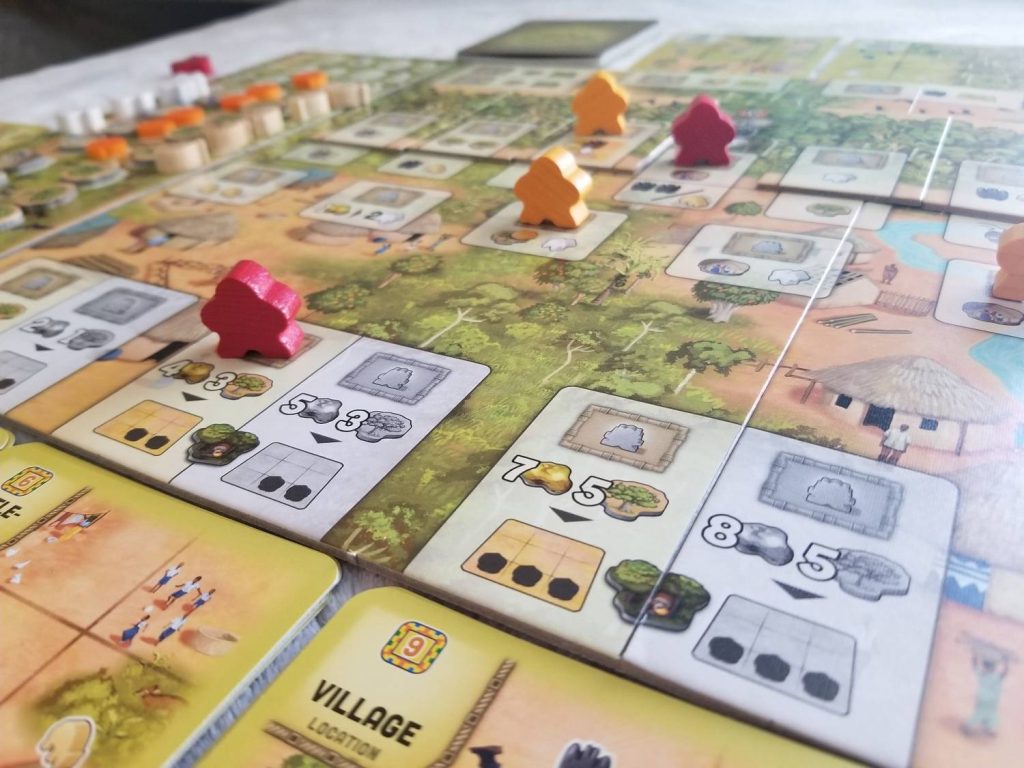
Which hotly contested action do you go for first? You’re going to want to do them all, but there’s a good chance the others will get taken before it comes back around to you. So, the question really becomes not one of what you should gain, but of what you’re willing to give up. And because of these kinds of moments, turn order is important.
But even that’s not cut and dried. Anytime someone adds to their tableau, they get to take the Start Player marker from its current owner. So, do you add to your tableau right now (maybe you need space to place a Goat, for instance) and risk having the Start Player marker taken away from you? Or do you hold out for as long as you can before adding to your tableau? If you wait until your third worker, you’ll be missing out on the opportunity to take that Goat. So, is getting your hands on the Start Player marker worth giving up that Goat over?
Decision-making moments like these abound. There’s no denying the satisfaction when it becomes abundantly clear that you made the right one. Just like there’s no denying the pleasure that comes from having to decide between two action spaces, hoping beyond all hope that the one you didn’t choose is still there when it comes back around to you, and having it actually still be there. It’s especially satisfying when you’re able to line things up so that one element of the game feeds another. During Maintenance, for instance, when those Trees you gained from your Wild Animals uncovers that piece of Fruit which unlocks a new Fruit bat.
I honestly can’t think of even a single negative thing to say about Atiwa. The game play is top notch and the components are excellent. They even gave me plenty of plastic bags inside the box, so I can’t even grouse about that. It’s just an all around fantastic game. In fact, I think that out of all of the new games I’ve experienced over this past year, it’s probably my favorite one.
Atiwa is the bee’s bat’s knees!


